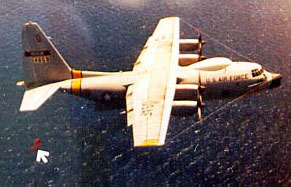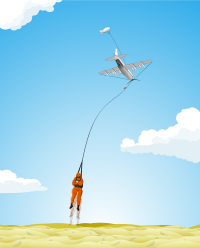Benutzer:Tangomoos/Artikelentwurf


Der Skyhook oder Fulton surface-to-air recovery system (STARS) ist ein System zur Aufnahme von Personen oder Lasten durch Flugzeuge, das von der Central Intelligence Agency (CIA), den United States Air Force und United States Navy entwickelt und benutzt wird. Verwendete Flugzeuge sind die MC-130E Combat Talon I und Boeing B-17. Eine Rettungsleine wird mittels eines BallonsIt involves using an overall-type harness and a self-inflating balloon with an attached lift line. An MC-130E engages the line with its V-shaped yoke and the person is reeled on board. Red flags on the lift line guide the pilot during daylight recoveries; lights on the lift line are used for night recoveries. Recovery kits were designed for one and two-man retrievals.
This system was developed by inventor Robert Edison Fulton, Jr., for the Central Intelligence Agency in the early 1950s. It was an evolution from a similar system[1] that was used during World War II by American and British forces to retrieve both personnel and downed assault gliders following airborne operations. The earlier system did not use a balloon, but a line stretched between a pair of poles set in the ground on either side of the person to be retrieved. An aircraft, usually a C-47 Skytrain, trailed a grappling hook that engaged the line, which was attached to the person to be retrieved.
Development of the recovery system[Bearbeiten | Quelltext bearbeiten]
Experiments with the recovery system began in 1950 by the CIA and Air Force. Using a weather balloon, nylon line, and weights of Vorlage:Convert, Fulton made numerous pickup attempts as he sought to develop a reliable procedure. Successful at last, Fulton took photographs made by his son to Admiral Luis de Florez, who had become the director of technical research at the CIA. Believing that the program could best be handled by the military, de Florez put Fulton in touch with the Office of Naval Research (ONR), where he obtained a development contract from ONR's Air Programs Division.
Over the next few years, Fulton refined the air and ground equipment for the pickup system. Based at El Centro, California, he conducted numerous flights over the Colorado Desert using a Navy P2V Neptune. He gradually increased the weight of the pickup until the line began to break. A braided nylon line with a test strength of Vorlage:Convert solved the problem. A major problem was the design of the locking device, or sky anchor, that secured the line to the aircraft. Fulton considered the solution of this problemVorlage:Clarify the most demanding part of the entire developmental process.
After experiments with instrumented dummies, Fulton continued to experiment with live pigs, as pigs have nervous systems close to humans. Lifted off the ground, the pig began to spin as it flew through the air at Vorlage:Convert. It arrived on board uninjured but in a disoriented state.[2]
By 1958, the Fulton aerial retrieval system, or "Skyhook", was finished. The ground system could be dropped from an aircraft and contained the necessary equipment for a pickup, including a harness—for cargo or a person—attached to a Vorlage:Convert high-strength, braided nylon line and a dirigible-shaped balloon inflated by a helium bottle.

The pickup aircraft was equipped with two tubular steel "horns"--Vorlage:Convert long and spread at a 70° angle from its nose. The aircraft flew into the line, aiming at a bright mylar marker placed at the Vorlage:Convert level. As the line was caught between the forks on the nose of the aircraft, the balloon was released and a spring-loaded trigger mechanism (sky anchor) secured the line to the aircraft. After the initial pickup, the line was snared by the pickup crew using a J-hook and attached to a powered winch and the person or cargo pulled on board. To prevent the pickup line from interfering with the aircraft's propellers in the case of an unsuccessful catch, the aircraft had deflector cables strung from the nose to the wingtips.
Later the US Navy tested the Fulton system fitted to modified S-2 Tracker carrier-based antisubmarine patrol aircraft for use in rescuing downed pilots. It is unknown whether a Fulton equipped S-2 was ever used on a combat mission.
First human pickups[Bearbeiten | Quelltext bearbeiten]

The CIA had secretly trained Special Activities Division paramilitary officers to use a predecessor system for human pickups as early as 1952. The first human recovery mission authorized for operational use of this "all American system" took place in Manchuria on 29 November 1952. CIA C-47 pilots Norman Schwartz and Robert Snoddy were trained in the aerial pickup technique towards the end of 1952. CIA paramilitary officers John T. Downey and Richard G. Fecteau, themselves hurriedly trained in the procedure during the week of 24 November, were to recover a courier who was in contact with anti-communist sympathizers in the area. The mission failed when Chinese forces downed the aircraft with small arms fire, capturing survivors Downey and Fecteau. The British allegedly also used the American system for personnel.[2]
The first human pickup using Fulton's STARS took place on 12 August 1958, when Staff Sergeant Levi W. Woods of the U.S. Marine Corps was winched on board the Neptune.[3] Because of the geometry involved, the person being picked up experienced less of a shock than during a parachute opening. After the initial contact, which was described by one individual as similar to "a kick in the pants", the person rose vertically at a slow rate to about Vorlage:Convert, then began to streamline behind the aircraft. Extension of arms and legs prevented spinning as the individual was winched on board. The process took about six minutes.
In August 1960, Capt. Edward A. Rodgers, commander of the Naval Air Development Unit, flew a Skyhook-equipped P2V to Point Barrow, Alaska, to conduct pickup tests under the direction of Dr. Max Brewer, head of the Navy's Arctic Research Laboratory. With Fulton on board to monitor the equipment, the Neptune picked up mail from Floating Ice Island T-3, also known as Fletcher's Ice Island, retrieved artifacts, including mastodon tusks, from an archaeological party on the tundra, and secured geological samples from Peters Lake Camp. The high point of the trials came when the P2V dropped a rescue package near the icebreaker Vorlage:USS. Retrieved by a ship's boat, the package was brought on deck, the balloon inflated, and the pickup accomplished.
Project Coldfeet[Bearbeiten | Quelltext bearbeiten]
The first operational use of Skyhook was Project COLDFEET, an examination of an abandoned Soviet drift station. Two agents parachuted to station NP 8 in May 1962. After 72 hours at the site, a pick-up was made of the Soviet equipment that had been gathered and of both men. The mission yielded information on the Soviet Union’s Arctic research activities, including evidence of advanced research on acoustical systems to detect under-ice submarines and efforts to develop Arctic anti-submarine warfare techniques.Vorlage:R
Later use[Bearbeiten | Quelltext bearbeiten]
The Fulton system was used from 1965 to 1996 on several variants of the C-130 Hercules including the MC-130s and HC-130s. It was also used on the C-123 Provider.[4] Despite the apparent high-risk nature of the system, only one fatal accident occurred in 17 years of use (in 1982). The increased availability of long-range helicopters such as the MH-53 Pave Low, HH-60 Pave Hawk and MH-47 Chinook, and the MV-22 Osprey and CV-22 Osprey tilt-rotor aircraft, all with aerial refueling capability, caused this system to be used less often. In September 1996, the Air Force Special Operations Command ceased maintaining the capability to deploy this system.
In popular culture[Bearbeiten | Quelltext bearbeiten]
The ancestor of the Fulton system has been explained and featured in the 1950 Buck Danny comic The Revenge of the Sons of Heaven.[5] The Fulton system itself has been featured in Atomic Alert of the same series.[6] The Skyhook has also been featured in a number of films. It was seen in the 1965 James Bond film Thunderball, where James Bond and his companion Domino Vitali are rescued at sea by a modified Boeing B-17 equipped with the Fulton system.[7] A few years later, it was also seen in the John Wayne movie The Green Berets to spirit a VC officer to South Vietnam.[8] The Skyhook system was also featured in the 2008 film The Dark Knight. First mentioned by Lucius Fox as a means of re-boarding an aircraft without it landing,[9] the system is attached to a Lockheed L-100 Hercules. It is used by Batman to kidnap the corrupt Chinese accountant Lau and escape the Hong Kong police, so that Batman could bring him back to Gotham City.[10][11][12] The Skyhook is also featured as a core gameplay mechanic in the video game Metal Gear Solid V: The Phantom Pain, however it functions differently from its real-life counterpart.[13]
See also[Bearbeiten | Quelltext bearbeiten]
References[Bearbeiten | Quelltext bearbeiten]
External links[Bearbeiten | Quelltext bearbeiten]
- web.archive.org Fehler bei Vorlage * Parametername unbekannt (Vorlage:Webarchiv): "date; title" Fehler bei Vorlage:Webarchiv: Genau einer der Parameter 'wayback', 'webciteID', 'archive-today', 'archive-is' oder 'archiv-url' muss angegeben werden. Fehler bei Vorlage:Webarchiv: enWP-Wert im Parameter 'url'.
- GlobalSecurity.org article
- High-resolution photo of HC-130 fitted for system, on www.airliners.net
- Two CIA Prisoners in China, 1952–73 — Central Intelligence Agency
Category:United States Air Force Special Operations Command Category:Rescue aviation
- ↑ Universal Newsreel (Hrsg.): Video: B-29s Rule Jap Skies,1944/12/18 (1944). 1944 (archive.org [abgerufen am 20. Februar 2012]).
- ↑ a b Robert Fultons Skyhook and Operation Coldfeet. In: Center for the Study of Intelligence. Central Intelligence Agency, abgerufen am 7. Dezember 2008.
- ↑ "500-Foot High Jump". Popular Mechanics, April 1960, p. 111.
- ↑ Phillip Friddell: Replica in Scale: 'Tis the Season---It's Our Christmas Special Edition Which Contains Some Tasty Transports, Some Colorful Jet Fighters, Odd Neptunes, Jugs, A Bird That Barely Flew, and a Blast From the Past. In: Replica in Scale. 18. Dezember 2010.
- ↑ US Military Aviation - Buck Danny. In: www.salimbeti.com. Abgerufen am 15. Juli 2018.
- ↑ US Military Aviation - Buck Danny. In: www.salimbeti.com. Abgerufen am 15. Juli 2018.
- ↑ Not just a flight of fancy: 'Skyhook' that rescued James Bond from the ocean at the end of Thunderball was designed to recover real-life CIA agents from behind enemy lines. In: Mail Online. Abgerufen am 12. Januar 2016.
- ↑ Fulton Recovery System.
- ↑ Vorlage:Cite AV media
- ↑ Vorlage:Cite AV media
- ↑ Andrew Pulver: Top 10 films set in Hong Kong. In: theguardian.com. The Guardian, abgerufen am 27. Oktober 2015.
- ↑ Peter Hall: Did You Know the Plane Extraction Scene from 'The Dark Knight' Used Real CIA Technology? In: movies.com. Abgerufen am 27. Oktober 2015.
- ↑ The True Story of ‘Metal Gear Solid’s’ Fulton Recovery System.